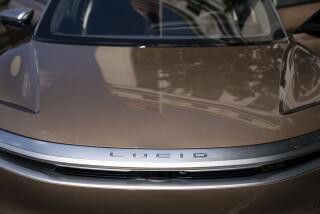The Big Three’s real union problem
The Big Three are a mess, and there is plenty of blame to go around. Washington lawmakers pondering the bailout for Detroit have been grilling executives of General Motors, Ford and Chrysler about their role in the crisis. But sitting by their side Thursday on Capitol Hill was Ron Gettelfinger, president of the United Auto Workers.
Even if a deal for a $15-billion to $17-billion preliminary bailout comes together this weekend to keep carmakers afloat into 2009, they will continue to be dogged by their most significant competitive disadvantage: a high-priced, unionized workforce. After all, hasn’t it always been the central goal of labor unions to maximize the per capita wage bill -- including medical and retirement benefits -- paid out to its membership? Maybe the UAW is simply too good at what it does.
It seemed clear from the hearings that to OK any larger bailout plan, Congress was going to insist on cutting labor costs. Already, Gettelfinger has coughed up concessions on job security protections and delayed payment to a retiree healthcare trust and is talking about modifying contracts.
And yet there is nothing inherently unsustainable about employing a high-priced, unionized workforce. The crisis of Detroit’s wage bill is entirely relative. Specifically, their labor costs far exceed the low-cost, nonunion American workforce at the U.S.-based, foreign-owned plants of competitors Toyota, Honda, Nissan and Subaru.
If the UAW really is to blame at all, then, it is because of the union’s utter failure to unionize any of the transplants. What has the UAW been doing all these years? Isn’t it the responsibility of any good union to protect union employers from competitive labor disadvantages by organizing wall to wall, throughout the industry? How could it have left these transplants unorganized?
As is now clear, when the UAW exposed the Big Three to insurmountable competitive disadvantages, it cut its own throat.
Perhaps these accusations seem overly harsh. After all, aren’t most of the transplants located in the right-to-work states of the Deep South? Some are, but this hardly explains why the UAW failed to organize the first Honda transplant, located not in Alabama but right in Ohio, the heart of the industrial Midwest.
Is transplant management the difference then? According to the prevailing wisdom, Japanese auto companies neither trust nor understand the American notion of labor unionism. Ah, but there’s the rub. The very companies that operate as nonunion transplants in the United States have always confronted a unionized workforce at home, organized by the Japanese Automobile Workers Confederation.
The UAW simply never established any sort of alliance with the Japanese Automobile Workers Confederation. And yet the UAW leadership knew plenty about Japan and the Japanese labor movement. The leader of the Japanese Automobile Workers Confederation was Ichiro Shioji. As David Halberstam noted in his 1986 book, “The Reckoning,” Shioji spent a year at Harvard in 1960 and then spent a summer at the UAW headquarters in Detroit, befriending all the major UAW leaders, including Walter Reuther, Leonard Woodcock and Douglas Fraser. Shioji was no stranger to the UAW.
Nor were the UAW leaders unfamiliar with Japan. In 1980, for example, UAW President Fraser (fresh off helping Chrysler secure its 1979 bailout) spent a week there talking with major Japanese car companies about building plants in the United States. Just before embarking on his trip, Fraser told a UAW convention that he would demand “that foreign companies that benefit from our markets contribute to them by building products here.” In a gesture of bravado that today seems almost suicidal, Fraser declared that “the U.S. market needs the discipline of foreign competition.”
In Japan, when companies were contemplating overseas transplants in the early ‘80s, Shioji held a de facto right to approve or disapprove the plans. He resisted efforts by Nissan to establish transplants in Britain, for instance, and the Financial Times reported how he could scuttle any deal: “Nissan probably could not go ahead in Britain without Shioji’s backing [because] the union would have to approve the transfer to the U.K. of key production staff.”
In the end, though, Shioji pushed for establishing Japanese transplants in the United States. It is a question for students of Japanese labor to explain why Shioji refused to protect his own union members from the threat of nonunion labor in the United States. But for students of American labor, the urgent question is whether the UAW even once asked its good friend Shioji to use his leverage in solidarity with American workers.
It is not too late to save the Big Three. But the solution is not to tear down the historic and heroic gains won by prior generations of UAW workers. If there is hope long term -- for the unionized Big Three companies and for the UAW -- it rests in dealing with the unfinished business of the 1980s: unionizing the unorganized transplants.
Jonathan Cutler is associate professor of sociology at Wesleyan University. He is the author of “Labor’s Time: Shorter Hours, the UAW, and the Struggle for American Unionism.”
More to Read
A cure for the common opinion
Get thought-provoking perspectives with our weekly newsletter.
You may occasionally receive promotional content from the Los Angeles Times.






